ECON 11026 Macroeconomics: RBA Interest Rate Decision Case Study
VerifiedAdded on 2023/04/21
|12
|3288
|400
Case Study
AI Summary
This case study delves into the Reserve Bank of Australia's (RBA) monetary policy decisions, particularly focusing on interest rate adjustments and their impact on the Australian economy. It examines the objectives of the RBA, including price stability, full employment, and economic prosperity, and how these objectives are pursued through monetary policy tools. The study analyzes the factors influencing the RBA's cash rate decisions, such as inflation, unemployment, wage growth, and the exchange rate. It further discusses the monetary transmission mechanism, illustrating how changes in the cash rate affect economic activity and inflation. The case study also considers the global economic context and domestic indicators that inform the RBA's policy choices. It references real-world data and potential economic scenarios to provide a comprehensive understanding of the RBA's role in managing the Australian economy.
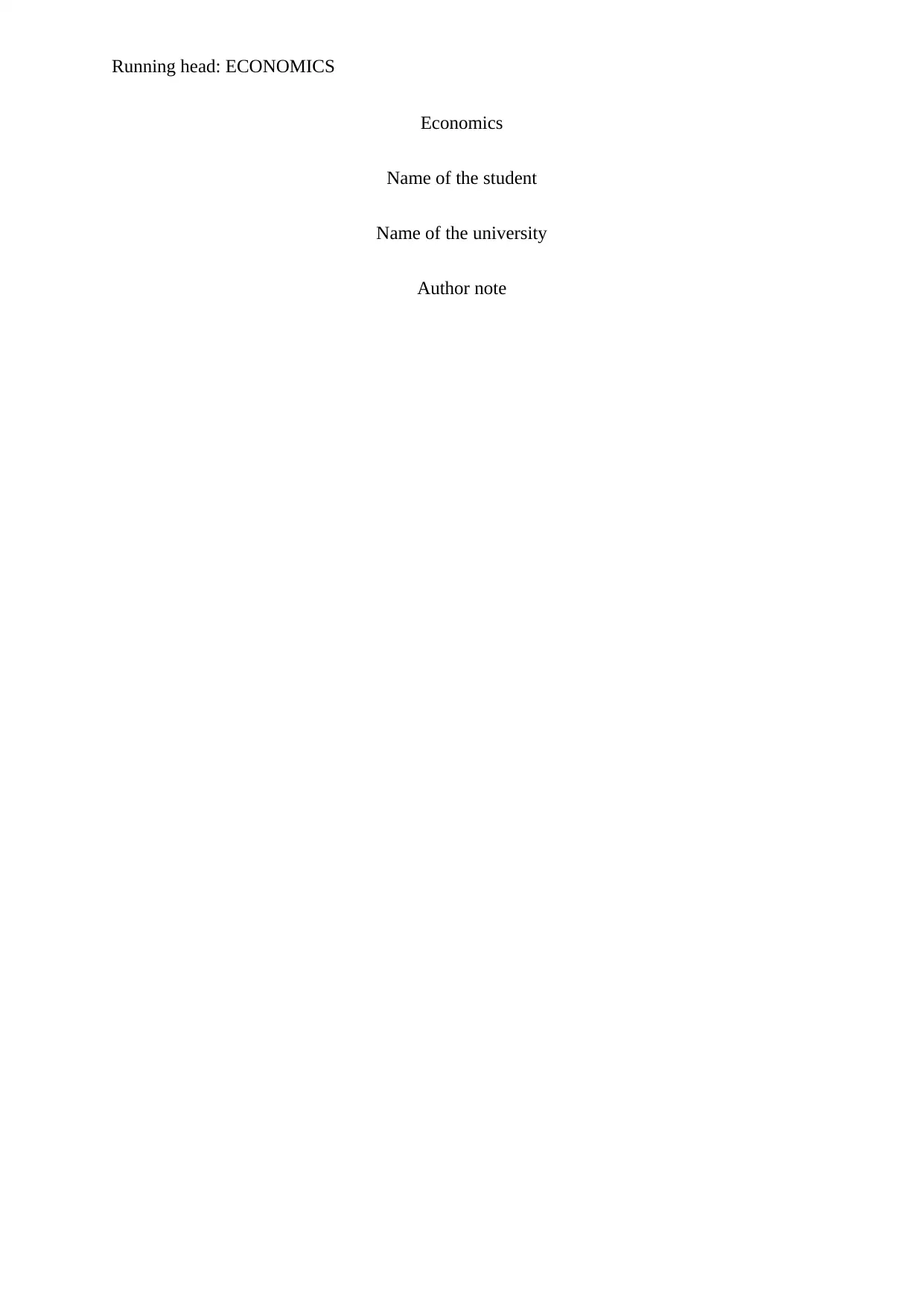
Running head: ECONOMICS
Economics
Name of the student
Name of the university
Author note
Economics
Name of the student
Name of the university
Author note
Paraphrase This Document
Need a fresh take? Get an instant paraphrase of this document with our AI Paraphraser
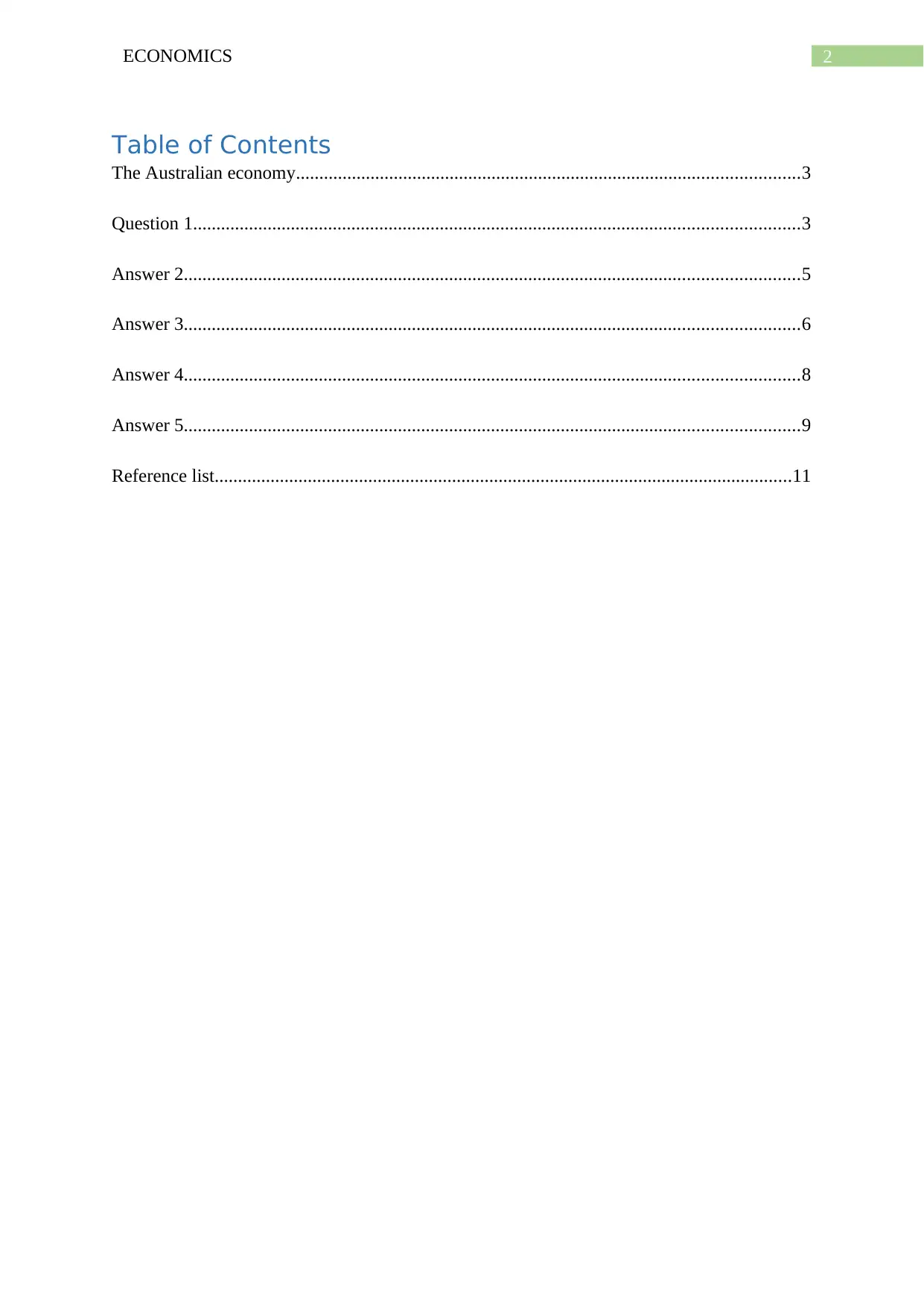
2ECONOMICS
Table of Contents
The Australian economy............................................................................................................3
Question 1..................................................................................................................................3
Answer 2....................................................................................................................................5
Answer 3....................................................................................................................................6
Answer 4....................................................................................................................................8
Answer 5....................................................................................................................................9
Reference list............................................................................................................................11
Table of Contents
The Australian economy............................................................................................................3
Question 1..................................................................................................................................3
Answer 2....................................................................................................................................5
Answer 3....................................................................................................................................6
Answer 4....................................................................................................................................8
Answer 5....................................................................................................................................9
Reference list............................................................................................................................11
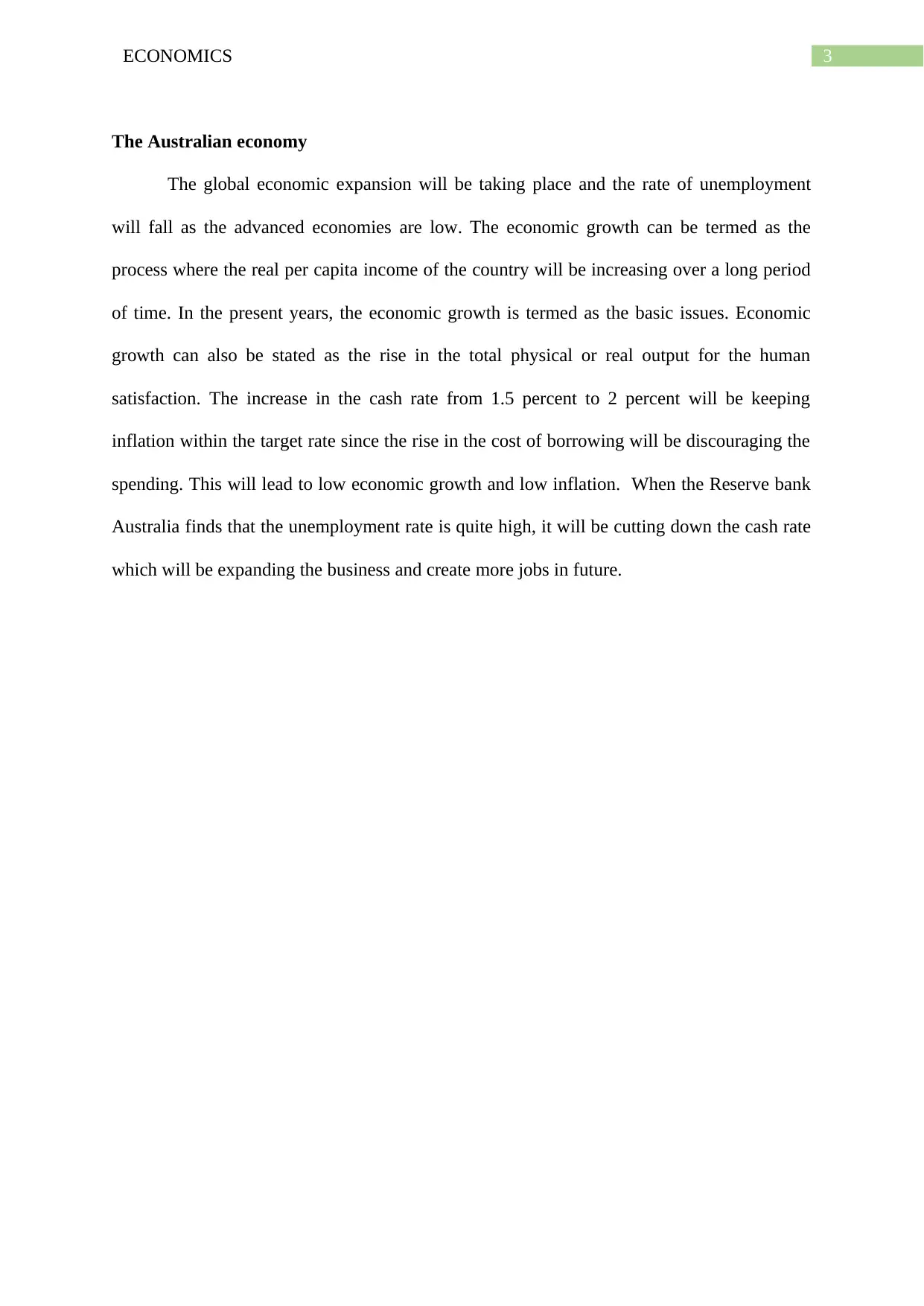
3ECONOMICS
The Australian economy
The global economic expansion will be taking place and the rate of unemployment
will fall as the advanced economies are low. The economic growth can be termed as the
process where the real per capita income of the country will be increasing over a long period
of time. In the present years, the economic growth is termed as the basic issues. Economic
growth can also be stated as the rise in the total physical or real output for the human
satisfaction. The increase in the cash rate from 1.5 percent to 2 percent will be keeping
inflation within the target rate since the rise in the cost of borrowing will be discouraging the
spending. This will lead to low economic growth and low inflation. When the Reserve bank
Australia finds that the unemployment rate is quite high, it will be cutting down the cash rate
which will be expanding the business and create more jobs in future.
The Australian economy
The global economic expansion will be taking place and the rate of unemployment
will fall as the advanced economies are low. The economic growth can be termed as the
process where the real per capita income of the country will be increasing over a long period
of time. In the present years, the economic growth is termed as the basic issues. Economic
growth can also be stated as the rise in the total physical or real output for the human
satisfaction. The increase in the cash rate from 1.5 percent to 2 percent will be keeping
inflation within the target rate since the rise in the cost of borrowing will be discouraging the
spending. This will lead to low economic growth and low inflation. When the Reserve bank
Australia finds that the unemployment rate is quite high, it will be cutting down the cash rate
which will be expanding the business and create more jobs in future.
⊘ This is a preview!⊘
Do you want full access?
Subscribe today to unlock all pages.

Trusted by 1+ million students worldwide
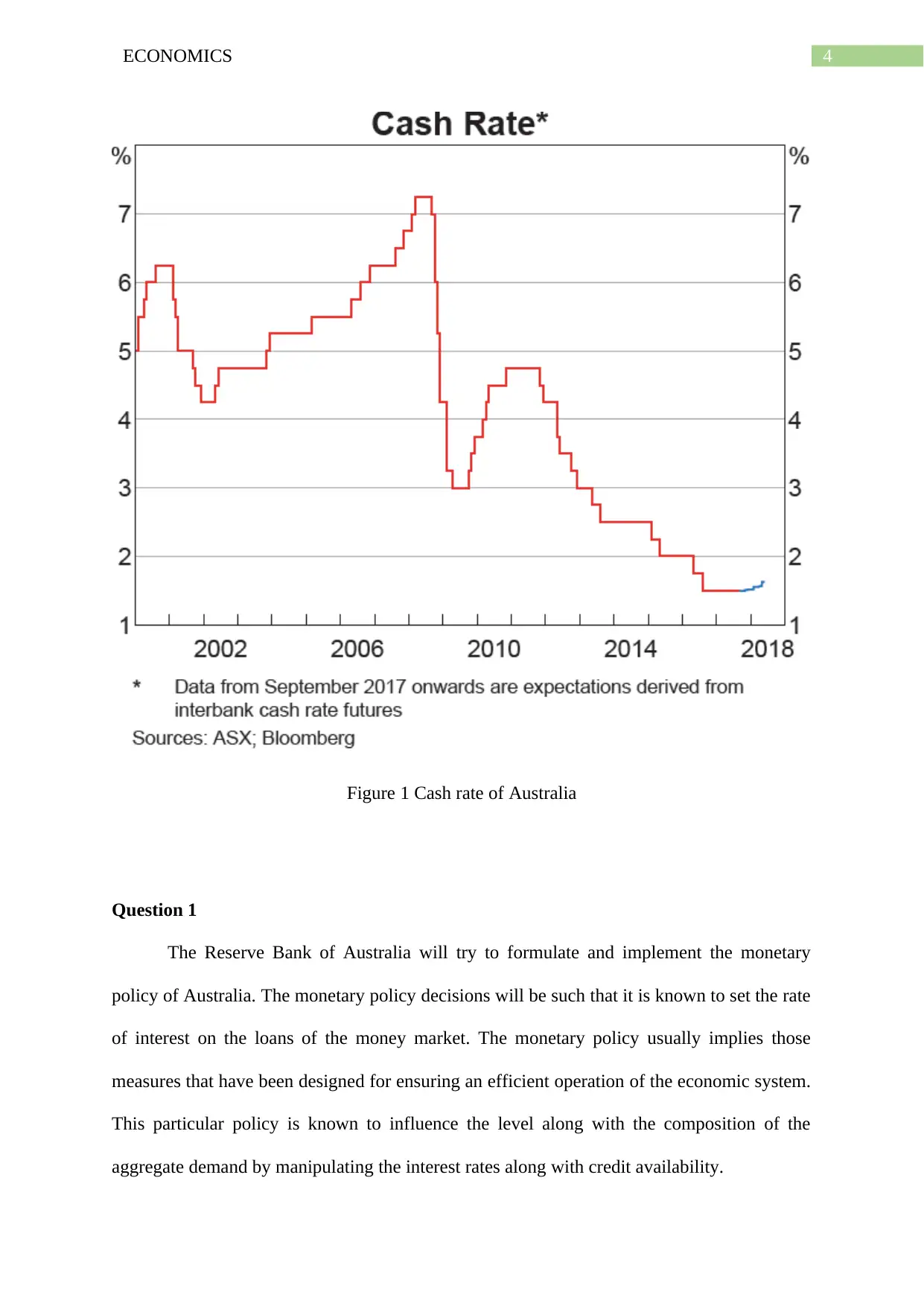
4ECONOMICS
Figure 1 Cash rate of Australia
Question 1
The Reserve Bank of Australia will try to formulate and implement the monetary
policy of Australia. The monetary policy decisions will be such that it is known to set the rate
of interest on the loans of the money market. The monetary policy usually implies those
measures that have been designed for ensuring an efficient operation of the economic system.
This particular policy is known to influence the level along with the composition of the
aggregate demand by manipulating the interest rates along with credit availability.
Figure 1 Cash rate of Australia
Question 1
The Reserve Bank of Australia will try to formulate and implement the monetary
policy of Australia. The monetary policy decisions will be such that it is known to set the rate
of interest on the loans of the money market. The monetary policy usually implies those
measures that have been designed for ensuring an efficient operation of the economic system.
This particular policy is known to influence the level along with the composition of the
aggregate demand by manipulating the interest rates along with credit availability.
Paraphrase This Document
Need a fresh take? Get an instant paraphrase of this document with our AI Paraphraser
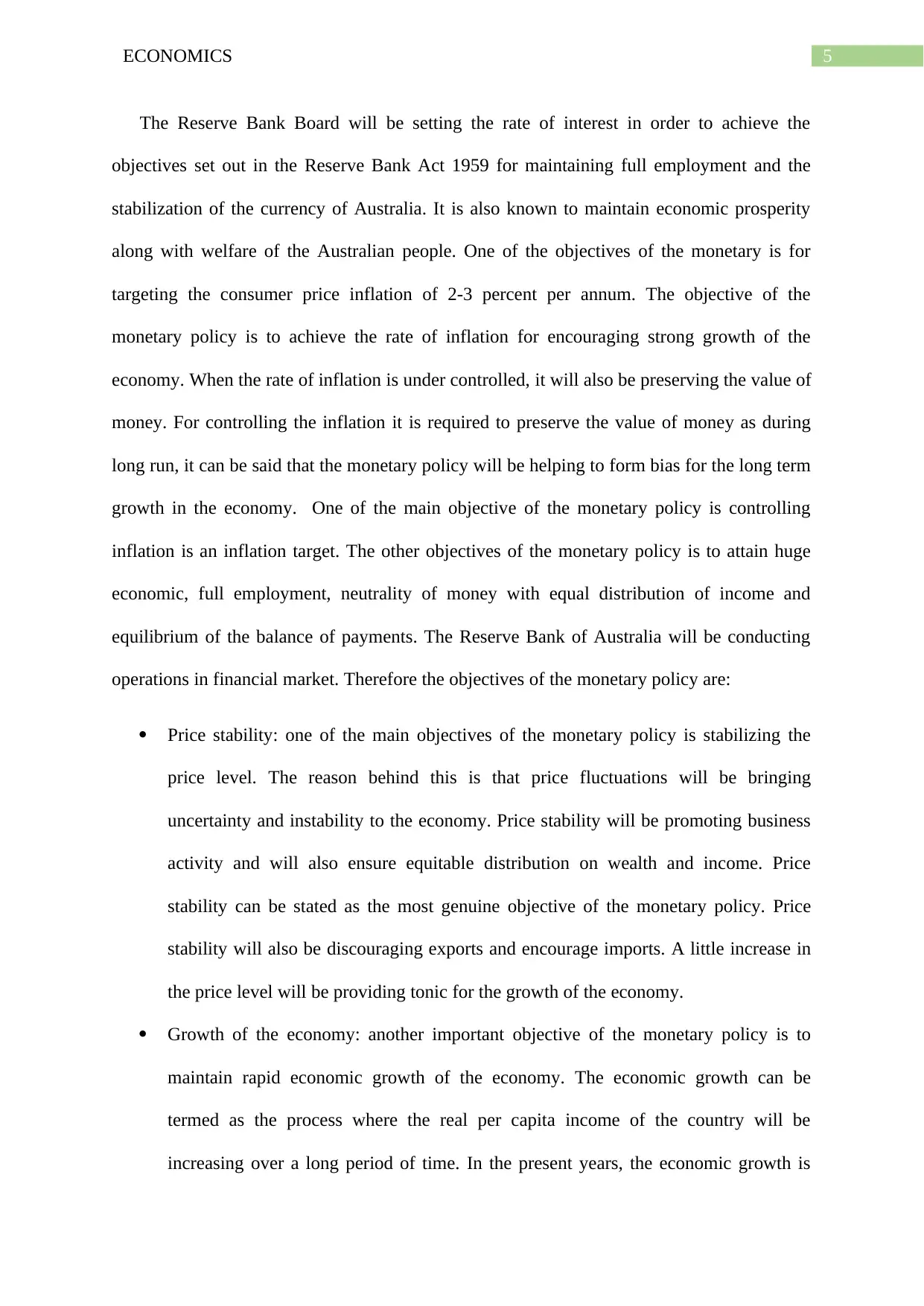
5ECONOMICS
The Reserve Bank Board will be setting the rate of interest in order to achieve the
objectives set out in the Reserve Bank Act 1959 for maintaining full employment and the
stabilization of the currency of Australia. It is also known to maintain economic prosperity
along with welfare of the Australian people. One of the objectives of the monetary is for
targeting the consumer price inflation of 2-3 percent per annum. The objective of the
monetary policy is to achieve the rate of inflation for encouraging strong growth of the
economy. When the rate of inflation is under controlled, it will also be preserving the value of
money. For controlling the inflation it is required to preserve the value of money as during
long run, it can be said that the monetary policy will be helping to form bias for the long term
growth in the economy. One of the main objective of the monetary policy is controlling
inflation is an inflation target. The other objectives of the monetary policy is to attain huge
economic, full employment, neutrality of money with equal distribution of income and
equilibrium of the balance of payments. The Reserve Bank of Australia will be conducting
operations in financial market. Therefore the objectives of the monetary policy are:
Price stability: one of the main objectives of the monetary policy is stabilizing the
price level. The reason behind this is that price fluctuations will be bringing
uncertainty and instability to the economy. Price stability will be promoting business
activity and will also ensure equitable distribution on wealth and income. Price
stability can be stated as the most genuine objective of the monetary policy. Price
stability will also be discouraging exports and encourage imports. A little increase in
the price level will be providing tonic for the growth of the economy.
Growth of the economy: another important objective of the monetary policy is to
maintain rapid economic growth of the economy. The economic growth can be
termed as the process where the real per capita income of the country will be
increasing over a long period of time. In the present years, the economic growth is
The Reserve Bank Board will be setting the rate of interest in order to achieve the
objectives set out in the Reserve Bank Act 1959 for maintaining full employment and the
stabilization of the currency of Australia. It is also known to maintain economic prosperity
along with welfare of the Australian people. One of the objectives of the monetary is for
targeting the consumer price inflation of 2-3 percent per annum. The objective of the
monetary policy is to achieve the rate of inflation for encouraging strong growth of the
economy. When the rate of inflation is under controlled, it will also be preserving the value of
money. For controlling the inflation it is required to preserve the value of money as during
long run, it can be said that the monetary policy will be helping to form bias for the long term
growth in the economy. One of the main objective of the monetary policy is controlling
inflation is an inflation target. The other objectives of the monetary policy is to attain huge
economic, full employment, neutrality of money with equal distribution of income and
equilibrium of the balance of payments. The Reserve Bank of Australia will be conducting
operations in financial market. Therefore the objectives of the monetary policy are:
Price stability: one of the main objectives of the monetary policy is stabilizing the
price level. The reason behind this is that price fluctuations will be bringing
uncertainty and instability to the economy. Price stability will be promoting business
activity and will also ensure equitable distribution on wealth and income. Price
stability can be stated as the most genuine objective of the monetary policy. Price
stability will also be discouraging exports and encourage imports. A little increase in
the price level will be providing tonic for the growth of the economy.
Growth of the economy: another important objective of the monetary policy is to
maintain rapid economic growth of the economy. The economic growth can be
termed as the process where the real per capita income of the country will be
increasing over a long period of time. In the present years, the economic growth is
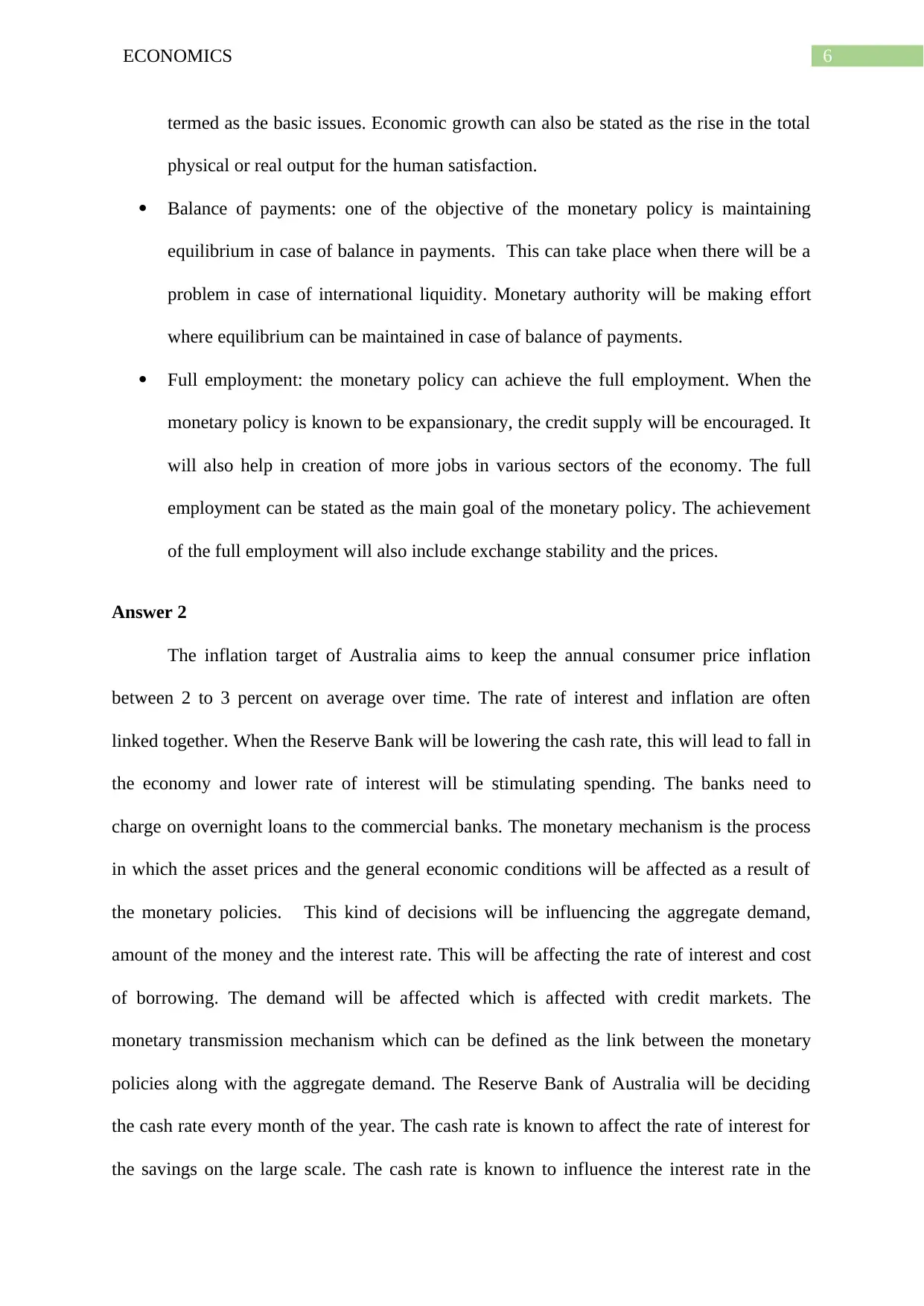
6ECONOMICS
termed as the basic issues. Economic growth can also be stated as the rise in the total
physical or real output for the human satisfaction.
Balance of payments: one of the objective of the monetary policy is maintaining
equilibrium in case of balance in payments. This can take place when there will be a
problem in case of international liquidity. Monetary authority will be making effort
where equilibrium can be maintained in case of balance of payments.
Full employment: the monetary policy can achieve the full employment. When the
monetary policy is known to be expansionary, the credit supply will be encouraged. It
will also help in creation of more jobs in various sectors of the economy. The full
employment can be stated as the main goal of the monetary policy. The achievement
of the full employment will also include exchange stability and the prices.
Answer 2
The inflation target of Australia aims to keep the annual consumer price inflation
between 2 to 3 percent on average over time. The rate of interest and inflation are often
linked together. When the Reserve Bank will be lowering the cash rate, this will lead to fall in
the economy and lower rate of interest will be stimulating spending. The banks need to
charge on overnight loans to the commercial banks. The monetary mechanism is the process
in which the asset prices and the general economic conditions will be affected as a result of
the monetary policies. This kind of decisions will be influencing the aggregate demand,
amount of the money and the interest rate. This will be affecting the rate of interest and cost
of borrowing. The demand will be affected which is affected with credit markets. The
monetary transmission mechanism which can be defined as the link between the monetary
policies along with the aggregate demand. The Reserve Bank of Australia will be deciding
the cash rate every month of the year. The cash rate is known to affect the rate of interest for
the savings on the large scale. The cash rate is known to influence the interest rate in the
termed as the basic issues. Economic growth can also be stated as the rise in the total
physical or real output for the human satisfaction.
Balance of payments: one of the objective of the monetary policy is maintaining
equilibrium in case of balance in payments. This can take place when there will be a
problem in case of international liquidity. Monetary authority will be making effort
where equilibrium can be maintained in case of balance of payments.
Full employment: the monetary policy can achieve the full employment. When the
monetary policy is known to be expansionary, the credit supply will be encouraged. It
will also help in creation of more jobs in various sectors of the economy. The full
employment can be stated as the main goal of the monetary policy. The achievement
of the full employment will also include exchange stability and the prices.
Answer 2
The inflation target of Australia aims to keep the annual consumer price inflation
between 2 to 3 percent on average over time. The rate of interest and inflation are often
linked together. When the Reserve Bank will be lowering the cash rate, this will lead to fall in
the economy and lower rate of interest will be stimulating spending. The banks need to
charge on overnight loans to the commercial banks. The monetary mechanism is the process
in which the asset prices and the general economic conditions will be affected as a result of
the monetary policies. This kind of decisions will be influencing the aggregate demand,
amount of the money and the interest rate. This will be affecting the rate of interest and cost
of borrowing. The demand will be affected which is affected with credit markets. The
monetary transmission mechanism which can be defined as the link between the monetary
policies along with the aggregate demand. The Reserve Bank of Australia will be deciding
the cash rate every month of the year. The cash rate is known to affect the rate of interest for
the savings on the large scale. The cash rate is known to influence the interest rate in the
⊘ This is a preview!⊘
Do you want full access?
Subscribe today to unlock all pages.

Trusted by 1+ million students worldwide
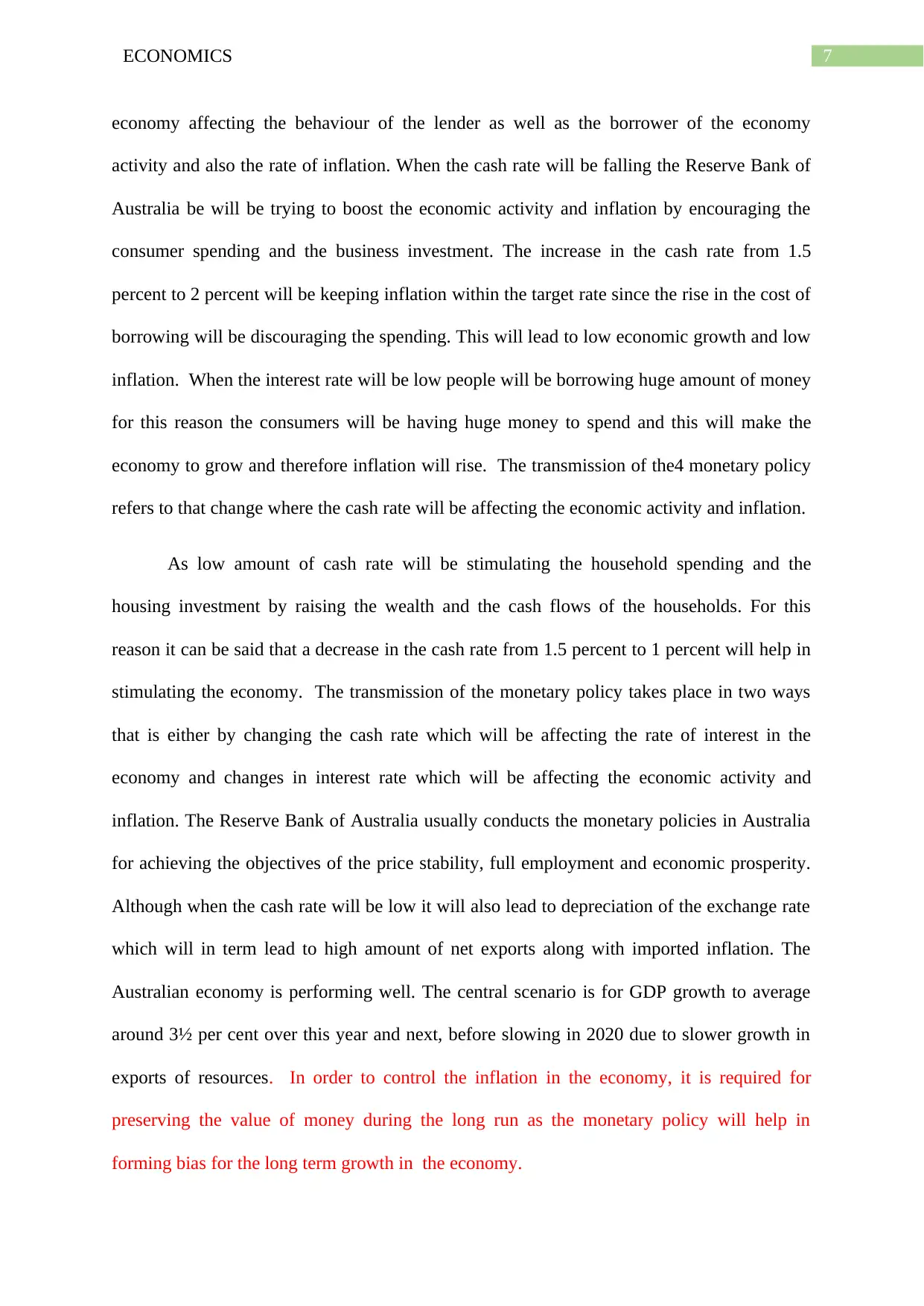
7ECONOMICS
economy affecting the behaviour of the lender as well as the borrower of the economy
activity and also the rate of inflation. When the cash rate will be falling the Reserve Bank of
Australia be will be trying to boost the economic activity and inflation by encouraging the
consumer spending and the business investment. The increase in the cash rate from 1.5
percent to 2 percent will be keeping inflation within the target rate since the rise in the cost of
borrowing will be discouraging the spending. This will lead to low economic growth and low
inflation. When the interest rate will be low people will be borrowing huge amount of money
for this reason the consumers will be having huge money to spend and this will make the
economy to grow and therefore inflation will rise. The transmission of the4 monetary policy
refers to that change where the cash rate will be affecting the economic activity and inflation.
As low amount of cash rate will be stimulating the household spending and the
housing investment by raising the wealth and the cash flows of the households. For this
reason it can be said that a decrease in the cash rate from 1.5 percent to 1 percent will help in
stimulating the economy. The transmission of the monetary policy takes place in two ways
that is either by changing the cash rate which will be affecting the rate of interest in the
economy and changes in interest rate which will be affecting the economic activity and
inflation. The Reserve Bank of Australia usually conducts the monetary policies in Australia
for achieving the objectives of the price stability, full employment and economic prosperity.
Although when the cash rate will be low it will also lead to depreciation of the exchange rate
which will in term lead to high amount of net exports along with imported inflation. The
Australian economy is performing well. The central scenario is for GDP growth to average
around 3½ per cent over this year and next, before slowing in 2020 due to slower growth in
exports of resources. In order to control the inflation in the economy, it is required for
preserving the value of money during the long run as the monetary policy will help in
forming bias for the long term growth in the economy.
economy affecting the behaviour of the lender as well as the borrower of the economy
activity and also the rate of inflation. When the cash rate will be falling the Reserve Bank of
Australia be will be trying to boost the economic activity and inflation by encouraging the
consumer spending and the business investment. The increase in the cash rate from 1.5
percent to 2 percent will be keeping inflation within the target rate since the rise in the cost of
borrowing will be discouraging the spending. This will lead to low economic growth and low
inflation. When the interest rate will be low people will be borrowing huge amount of money
for this reason the consumers will be having huge money to spend and this will make the
economy to grow and therefore inflation will rise. The transmission of the4 monetary policy
refers to that change where the cash rate will be affecting the economic activity and inflation.
As low amount of cash rate will be stimulating the household spending and the
housing investment by raising the wealth and the cash flows of the households. For this
reason it can be said that a decrease in the cash rate from 1.5 percent to 1 percent will help in
stimulating the economy. The transmission of the monetary policy takes place in two ways
that is either by changing the cash rate which will be affecting the rate of interest in the
economy and changes in interest rate which will be affecting the economic activity and
inflation. The Reserve Bank of Australia usually conducts the monetary policies in Australia
for achieving the objectives of the price stability, full employment and economic prosperity.
Although when the cash rate will be low it will also lead to depreciation of the exchange rate
which will in term lead to high amount of net exports along with imported inflation. The
Australian economy is performing well. The central scenario is for GDP growth to average
around 3½ per cent over this year and next, before slowing in 2020 due to slower growth in
exports of resources. In order to control the inflation in the economy, it is required for
preserving the value of money during the long run as the monetary policy will help in
forming bias for the long term growth in the economy.
Paraphrase This Document
Need a fresh take? Get an instant paraphrase of this document with our AI Paraphraser
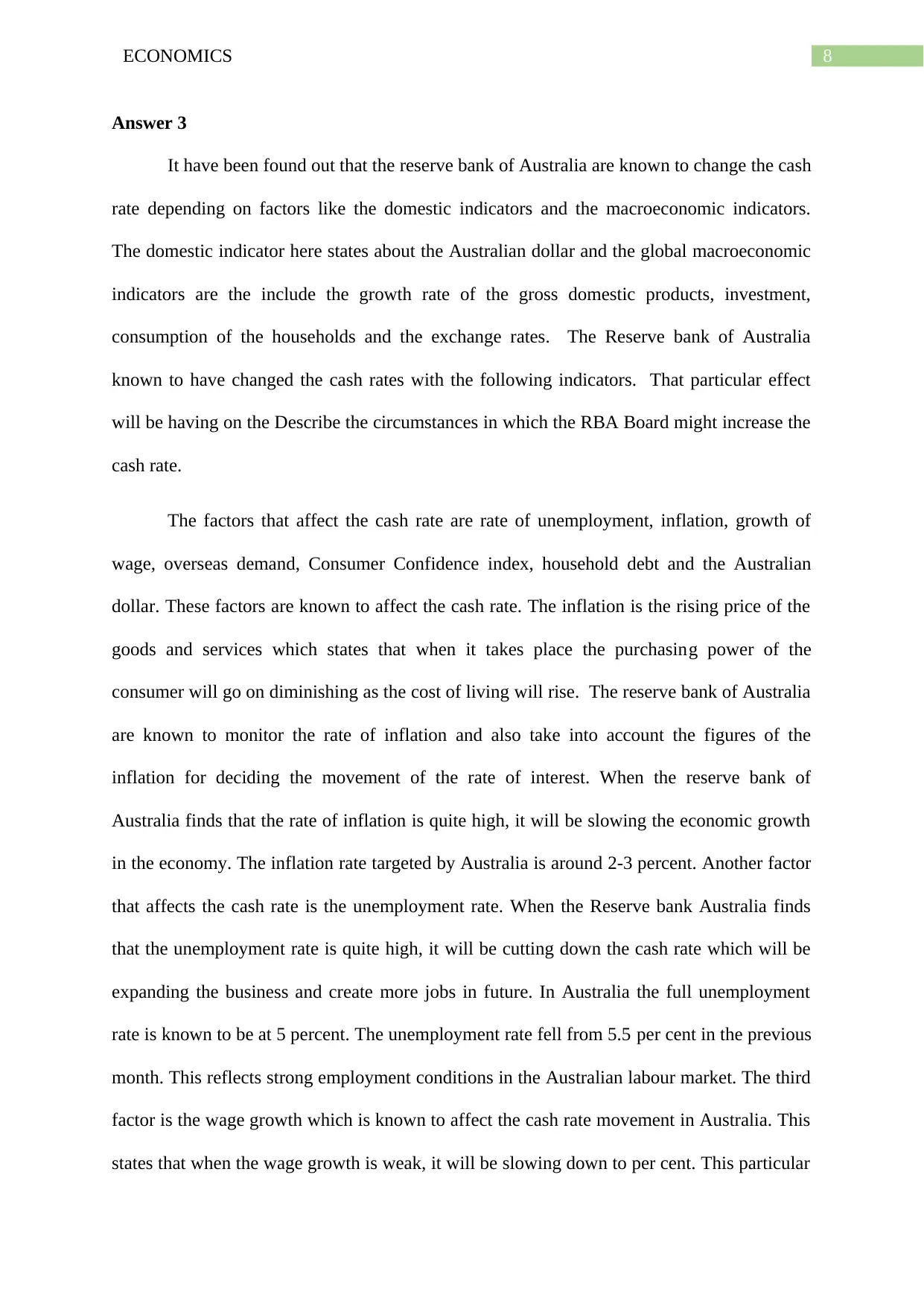
8ECONOMICS
Answer 3
It have been found out that the reserve bank of Australia are known to change the cash
rate depending on factors like the domestic indicators and the macroeconomic indicators.
The domestic indicator here states about the Australian dollar and the global macroeconomic
indicators are the include the growth rate of the gross domestic products, investment,
consumption of the households and the exchange rates. The Reserve bank of Australia
known to have changed the cash rates with the following indicators. That particular effect
will be having on the Describe the circumstances in which the RBA Board might increase the
cash rate.
The factors that affect the cash rate are rate of unemployment, inflation, growth of
wage, overseas demand, Consumer Confidence index, household debt and the Australian
dollar. These factors are known to affect the cash rate. The inflation is the rising price of the
goods and services which states that when it takes place the purchasing power of the
consumer will go on diminishing as the cost of living will rise. The reserve bank of Australia
are known to monitor the rate of inflation and also take into account the figures of the
inflation for deciding the movement of the rate of interest. When the reserve bank of
Australia finds that the rate of inflation is quite high, it will be slowing the economic growth
in the economy. The inflation rate targeted by Australia is around 2-3 percent. Another factor
that affects the cash rate is the unemployment rate. When the Reserve bank Australia finds
that the unemployment rate is quite high, it will be cutting down the cash rate which will be
expanding the business and create more jobs in future. In Australia the full unemployment
rate is known to be at 5 percent. The unemployment rate fell from 5.5 per cent in the previous
month. This reflects strong employment conditions in the Australian labour market. The third
factor is the wage growth which is known to affect the cash rate movement in Australia. This
states that when the wage growth is weak, it will be slowing down to per cent. This particular
Answer 3
It have been found out that the reserve bank of Australia are known to change the cash
rate depending on factors like the domestic indicators and the macroeconomic indicators.
The domestic indicator here states about the Australian dollar and the global macroeconomic
indicators are the include the growth rate of the gross domestic products, investment,
consumption of the households and the exchange rates. The Reserve bank of Australia
known to have changed the cash rates with the following indicators. That particular effect
will be having on the Describe the circumstances in which the RBA Board might increase the
cash rate.
The factors that affect the cash rate are rate of unemployment, inflation, growth of
wage, overseas demand, Consumer Confidence index, household debt and the Australian
dollar. These factors are known to affect the cash rate. The inflation is the rising price of the
goods and services which states that when it takes place the purchasing power of the
consumer will go on diminishing as the cost of living will rise. The reserve bank of Australia
are known to monitor the rate of inflation and also take into account the figures of the
inflation for deciding the movement of the rate of interest. When the reserve bank of
Australia finds that the rate of inflation is quite high, it will be slowing the economic growth
in the economy. The inflation rate targeted by Australia is around 2-3 percent. Another factor
that affects the cash rate is the unemployment rate. When the Reserve bank Australia finds
that the unemployment rate is quite high, it will be cutting down the cash rate which will be
expanding the business and create more jobs in future. In Australia the full unemployment
rate is known to be at 5 percent. The unemployment rate fell from 5.5 per cent in the previous
month. This reflects strong employment conditions in the Australian labour market. The third
factor is the wage growth which is known to affect the cash rate movement in Australia. This
states that when the wage growth is weak, it will be slowing down to per cent. This particular
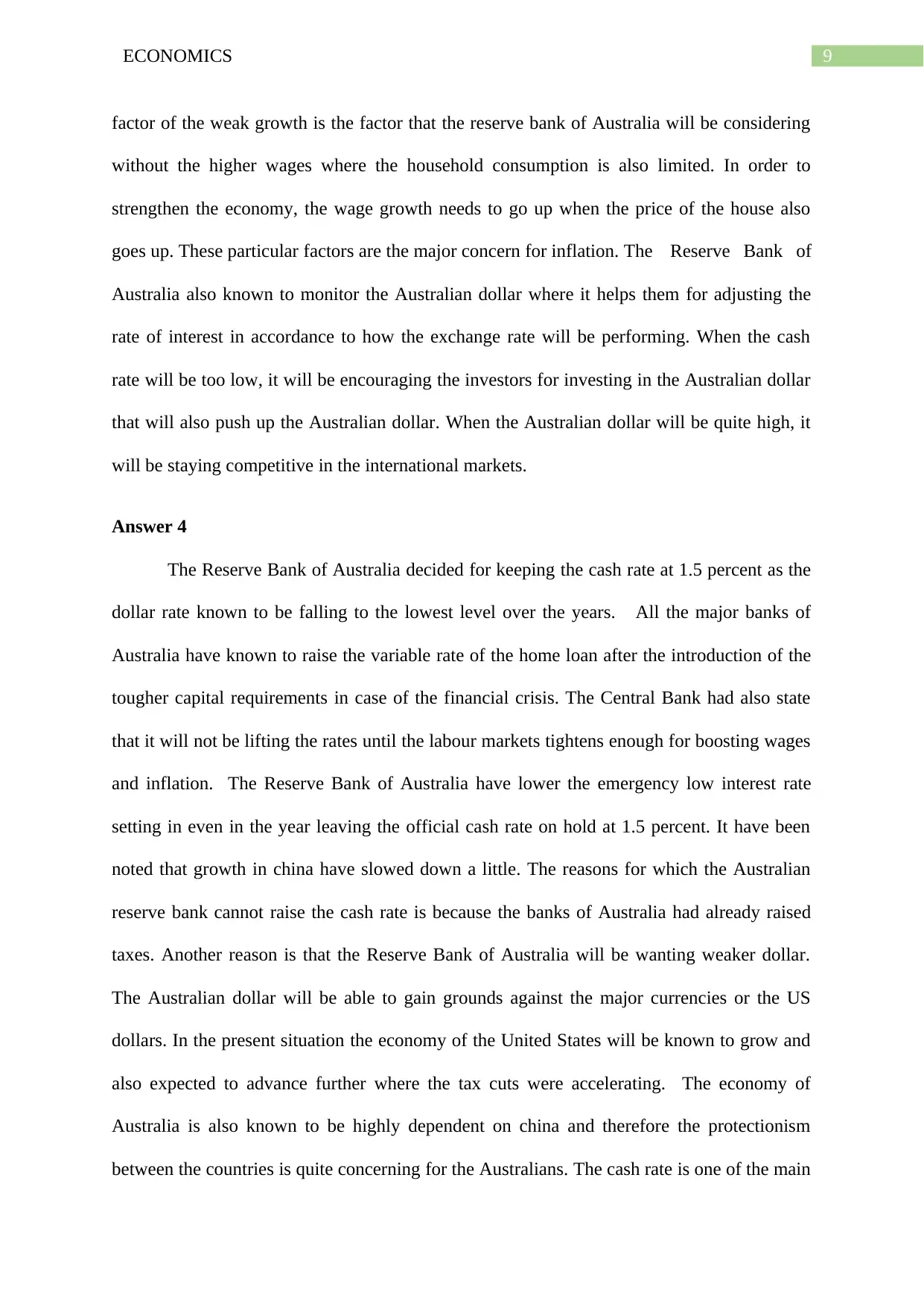
9ECONOMICS
factor of the weak growth is the factor that the reserve bank of Australia will be considering
without the higher wages where the household consumption is also limited. In order to
strengthen the economy, the wage growth needs to go up when the price of the house also
goes up. These particular factors are the major concern for inflation. The Reserve Bank of
Australia also known to monitor the Australian dollar where it helps them for adjusting the
rate of interest in accordance to how the exchange rate will be performing. When the cash
rate will be too low, it will be encouraging the investors for investing in the Australian dollar
that will also push up the Australian dollar. When the Australian dollar will be quite high, it
will be staying competitive in the international markets.
Answer 4
The Reserve Bank of Australia decided for keeping the cash rate at 1.5 percent as the
dollar rate known to be falling to the lowest level over the years. All the major banks of
Australia have known to raise the variable rate of the home loan after the introduction of the
tougher capital requirements in case of the financial crisis. The Central Bank had also state
that it will not be lifting the rates until the labour markets tightens enough for boosting wages
and inflation. The Reserve Bank of Australia have lower the emergency low interest rate
setting in even in the year leaving the official cash rate on hold at 1.5 percent. It have been
noted that growth in china have slowed down a little. The reasons for which the Australian
reserve bank cannot raise the cash rate is because the banks of Australia had already raised
taxes. Another reason is that the Reserve Bank of Australia will be wanting weaker dollar.
The Australian dollar will be able to gain grounds against the major currencies or the US
dollars. In the present situation the economy of the United States will be known to grow and
also expected to advance further where the tax cuts were accelerating. The economy of
Australia is also known to be highly dependent on china and therefore the protectionism
between the countries is quite concerning for the Australians. The cash rate is one of the main
factor of the weak growth is the factor that the reserve bank of Australia will be considering
without the higher wages where the household consumption is also limited. In order to
strengthen the economy, the wage growth needs to go up when the price of the house also
goes up. These particular factors are the major concern for inflation. The Reserve Bank of
Australia also known to monitor the Australian dollar where it helps them for adjusting the
rate of interest in accordance to how the exchange rate will be performing. When the cash
rate will be too low, it will be encouraging the investors for investing in the Australian dollar
that will also push up the Australian dollar. When the Australian dollar will be quite high, it
will be staying competitive in the international markets.
Answer 4
The Reserve Bank of Australia decided for keeping the cash rate at 1.5 percent as the
dollar rate known to be falling to the lowest level over the years. All the major banks of
Australia have known to raise the variable rate of the home loan after the introduction of the
tougher capital requirements in case of the financial crisis. The Central Bank had also state
that it will not be lifting the rates until the labour markets tightens enough for boosting wages
and inflation. The Reserve Bank of Australia have lower the emergency low interest rate
setting in even in the year leaving the official cash rate on hold at 1.5 percent. It have been
noted that growth in china have slowed down a little. The reasons for which the Australian
reserve bank cannot raise the cash rate is because the banks of Australia had already raised
taxes. Another reason is that the Reserve Bank of Australia will be wanting weaker dollar.
The Australian dollar will be able to gain grounds against the major currencies or the US
dollars. In the present situation the economy of the United States will be known to grow and
also expected to advance further where the tax cuts were accelerating. The economy of
Australia is also known to be highly dependent on china and therefore the protectionism
between the countries is quite concerning for the Australians. The cash rate is one of the main
⊘ This is a preview!⊘
Do you want full access?
Subscribe today to unlock all pages.

Trusted by 1+ million students worldwide
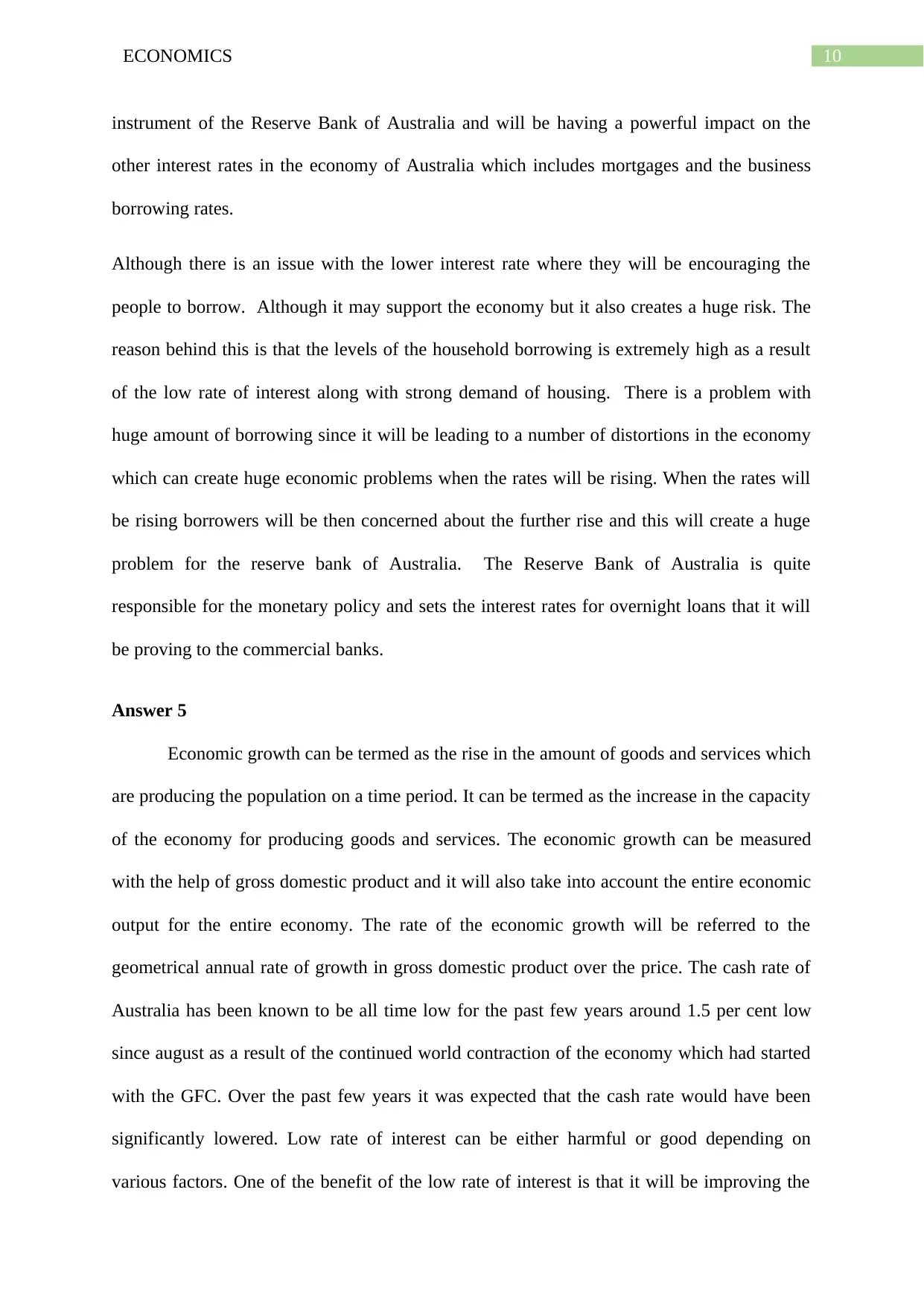
10ECONOMICS
instrument of the Reserve Bank of Australia and will be having a powerful impact on the
other interest rates in the economy of Australia which includes mortgages and the business
borrowing rates.
Although there is an issue with the lower interest rate where they will be encouraging the
people to borrow. Although it may support the economy but it also creates a huge risk. The
reason behind this is that the levels of the household borrowing is extremely high as a result
of the low rate of interest along with strong demand of housing. There is a problem with
huge amount of borrowing since it will be leading to a number of distortions in the economy
which can create huge economic problems when the rates will be rising. When the rates will
be rising borrowers will be then concerned about the further rise and this will create a huge
problem for the reserve bank of Australia. The Reserve Bank of Australia is quite
responsible for the monetary policy and sets the interest rates for overnight loans that it will
be proving to the commercial banks.
Answer 5
Economic growth can be termed as the rise in the amount of goods and services which
are producing the population on a time period. It can be termed as the increase in the capacity
of the economy for producing goods and services. The economic growth can be measured
with the help of gross domestic product and it will also take into account the entire economic
output for the entire economy. The rate of the economic growth will be referred to the
geometrical annual rate of growth in gross domestic product over the price. The cash rate of
Australia has been known to be all time low for the past few years around 1.5 per cent low
since august as a result of the continued world contraction of the economy which had started
with the GFC. Over the past few years it was expected that the cash rate would have been
significantly lowered. Low rate of interest can be either harmful or good depending on
various factors. One of the benefit of the low rate of interest is that it will be improving the
instrument of the Reserve Bank of Australia and will be having a powerful impact on the
other interest rates in the economy of Australia which includes mortgages and the business
borrowing rates.
Although there is an issue with the lower interest rate where they will be encouraging the
people to borrow. Although it may support the economy but it also creates a huge risk. The
reason behind this is that the levels of the household borrowing is extremely high as a result
of the low rate of interest along with strong demand of housing. There is a problem with
huge amount of borrowing since it will be leading to a number of distortions in the economy
which can create huge economic problems when the rates will be rising. When the rates will
be rising borrowers will be then concerned about the further rise and this will create a huge
problem for the reserve bank of Australia. The Reserve Bank of Australia is quite
responsible for the monetary policy and sets the interest rates for overnight loans that it will
be proving to the commercial banks.
Answer 5
Economic growth can be termed as the rise in the amount of goods and services which
are producing the population on a time period. It can be termed as the increase in the capacity
of the economy for producing goods and services. The economic growth can be measured
with the help of gross domestic product and it will also take into account the entire economic
output for the entire economy. The rate of the economic growth will be referred to the
geometrical annual rate of growth in gross domestic product over the price. The cash rate of
Australia has been known to be all time low for the past few years around 1.5 per cent low
since august as a result of the continued world contraction of the economy which had started
with the GFC. Over the past few years it was expected that the cash rate would have been
significantly lowered. Low rate of interest can be either harmful or good depending on
various factors. One of the benefit of the low rate of interest is that it will be improving the
Paraphrase This Document
Need a fresh take? Get an instant paraphrase of this document with our AI Paraphraser
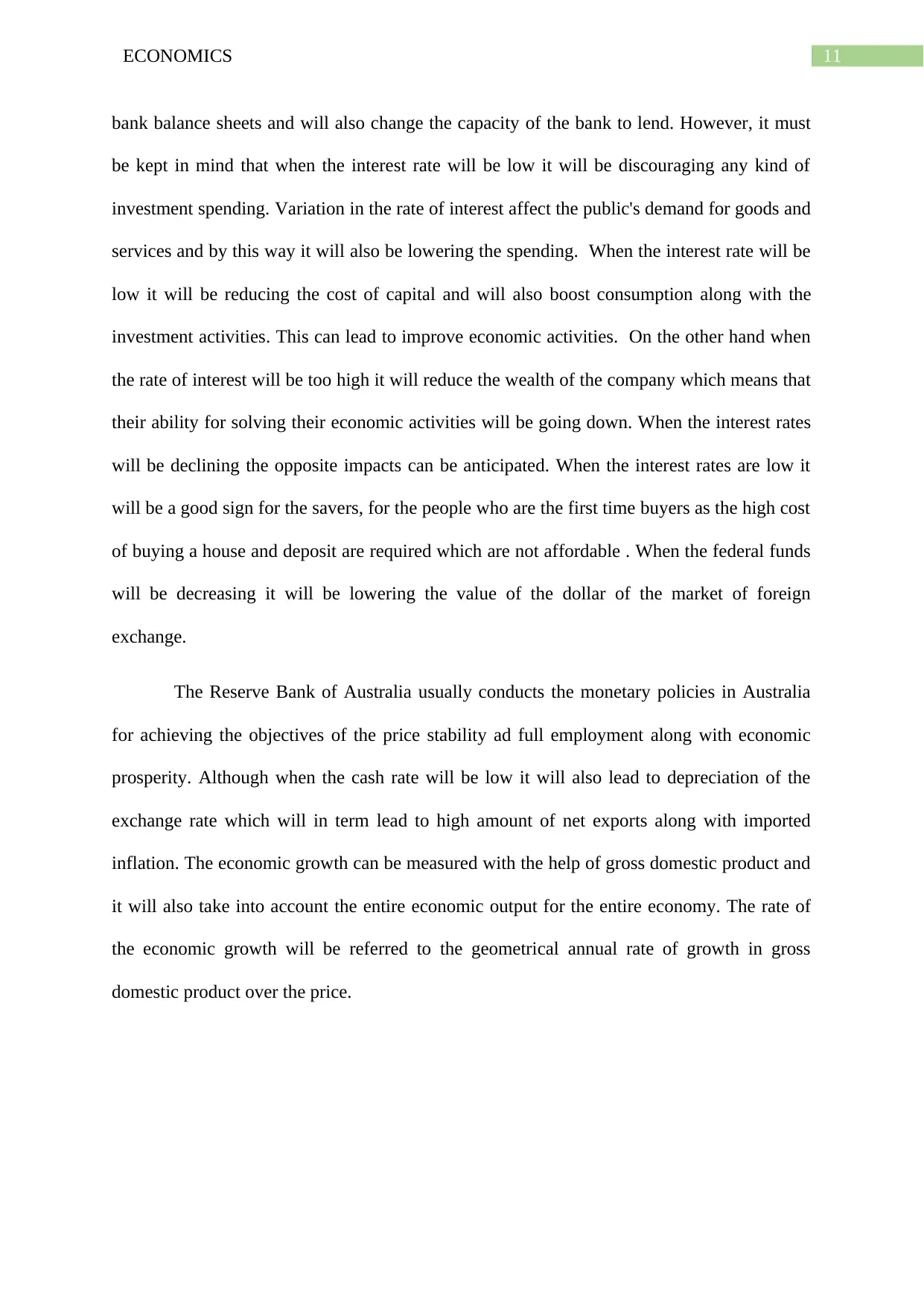
11ECONOMICS
bank balance sheets and will also change the capacity of the bank to lend. However, it must
be kept in mind that when the interest rate will be low it will be discouraging any kind of
investment spending. Variation in the rate of interest affect the public's demand for goods and
services and by this way it will also be lowering the spending. When the interest rate will be
low it will be reducing the cost of capital and will also boost consumption along with the
investment activities. This can lead to improve economic activities. On the other hand when
the rate of interest will be too high it will reduce the wealth of the company which means that
their ability for solving their economic activities will be going down. When the interest rates
will be declining the opposite impacts can be anticipated. When the interest rates are low it
will be a good sign for the savers, for the people who are the first time buyers as the high cost
of buying a house and deposit are required which are not affordable . When the federal funds
will be decreasing it will be lowering the value of the dollar of the market of foreign
exchange.
The Reserve Bank of Australia usually conducts the monetary policies in Australia
for achieving the objectives of the price stability ad full employment along with economic
prosperity. Although when the cash rate will be low it will also lead to depreciation of the
exchange rate which will in term lead to high amount of net exports along with imported
inflation. The economic growth can be measured with the help of gross domestic product and
it will also take into account the entire economic output for the entire economy. The rate of
the economic growth will be referred to the geometrical annual rate of growth in gross
domestic product over the price.
bank balance sheets and will also change the capacity of the bank to lend. However, it must
be kept in mind that when the interest rate will be low it will be discouraging any kind of
investment spending. Variation in the rate of interest affect the public's demand for goods and
services and by this way it will also be lowering the spending. When the interest rate will be
low it will be reducing the cost of capital and will also boost consumption along with the
investment activities. This can lead to improve economic activities. On the other hand when
the rate of interest will be too high it will reduce the wealth of the company which means that
their ability for solving their economic activities will be going down. When the interest rates
will be declining the opposite impacts can be anticipated. When the interest rates are low it
will be a good sign for the savers, for the people who are the first time buyers as the high cost
of buying a house and deposit are required which are not affordable . When the federal funds
will be decreasing it will be lowering the value of the dollar of the market of foreign
exchange.
The Reserve Bank of Australia usually conducts the monetary policies in Australia
for achieving the objectives of the price stability ad full employment along with economic
prosperity. Although when the cash rate will be low it will also lead to depreciation of the
exchange rate which will in term lead to high amount of net exports along with imported
inflation. The economic growth can be measured with the help of gross domestic product and
it will also take into account the entire economic output for the entire economy. The rate of
the economic growth will be referred to the geometrical annual rate of growth in gross
domestic product over the price.
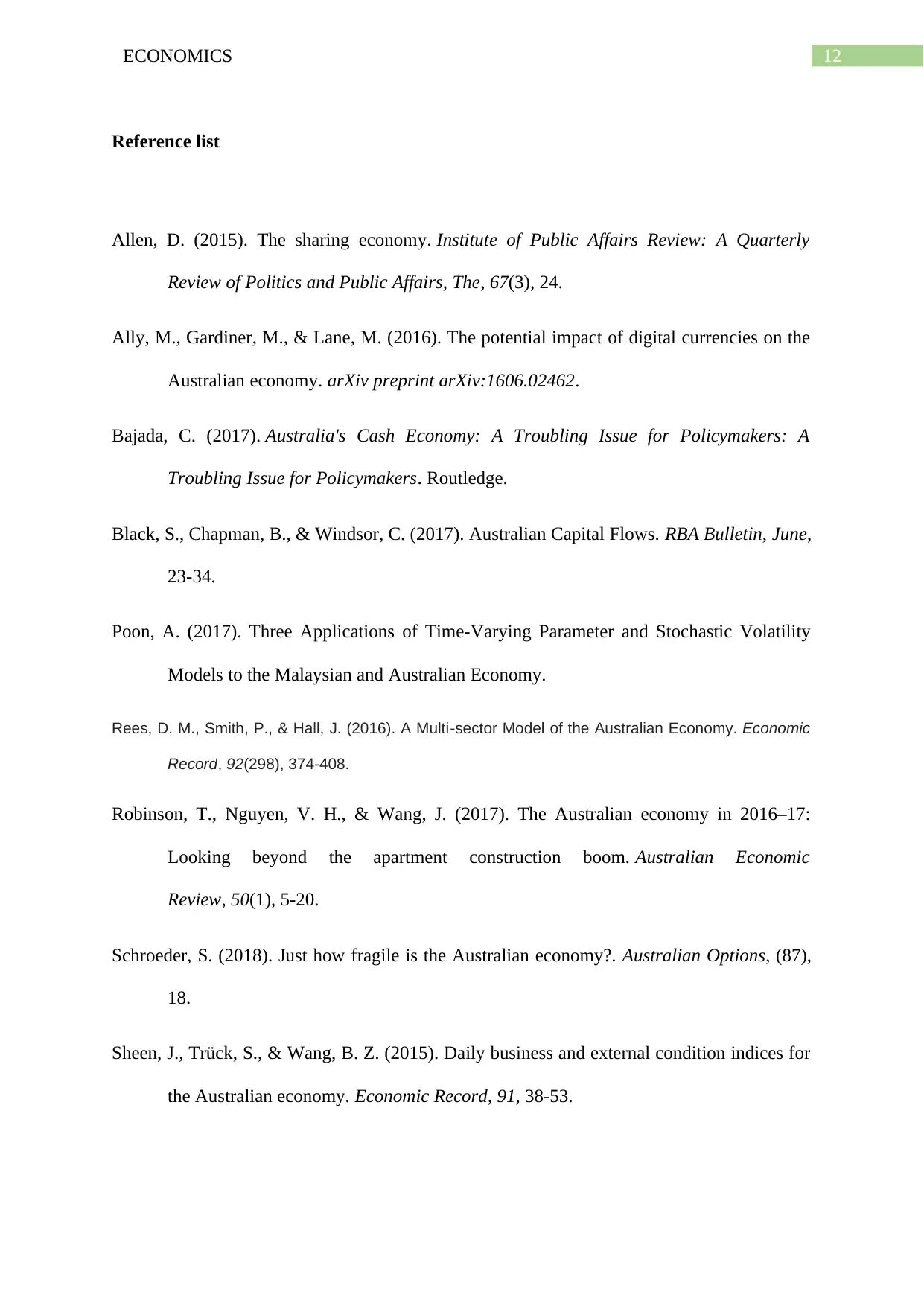
12ECONOMICS
Reference list
Allen, D. (2015). The sharing economy. Institute of Public Affairs Review: A Quarterly
Review of Politics and Public Affairs, The, 67(3), 24.
Ally, M., Gardiner, M., & Lane, M. (2016). The potential impact of digital currencies on the
Australian economy. arXiv preprint arXiv:1606.02462.
Bajada, C. (2017). Australia's Cash Economy: A Troubling Issue for Policymakers: A
Troubling Issue for Policymakers. Routledge.
Black, S., Chapman, B., & Windsor, C. (2017). Australian Capital Flows. RBA Bulletin, June,
23-34.
Poon, A. (2017). Three Applications of Time-Varying Parameter and Stochastic Volatility
Models to the Malaysian and Australian Economy.
Rees, D. M., Smith, P., & Hall, J. (2016). A Multi‐sector Model of the Australian Economy. Economic
Record, 92(298), 374-408.
Robinson, T., Nguyen, V. H., & Wang, J. (2017). The Australian economy in 2016–17:
Looking beyond the apartment construction boom. Australian Economic
Review, 50(1), 5-20.
Schroeder, S. (2018). Just how fragile is the Australian economy?. Australian Options, (87),
18.
Sheen, J., Trück, S., & Wang, B. Z. (2015). Daily business and external condition indices for
the Australian economy. Economic Record, 91, 38-53.
Reference list
Allen, D. (2015). The sharing economy. Institute of Public Affairs Review: A Quarterly
Review of Politics and Public Affairs, The, 67(3), 24.
Ally, M., Gardiner, M., & Lane, M. (2016). The potential impact of digital currencies on the
Australian economy. arXiv preprint arXiv:1606.02462.
Bajada, C. (2017). Australia's Cash Economy: A Troubling Issue for Policymakers: A
Troubling Issue for Policymakers. Routledge.
Black, S., Chapman, B., & Windsor, C. (2017). Australian Capital Flows. RBA Bulletin, June,
23-34.
Poon, A. (2017). Three Applications of Time-Varying Parameter and Stochastic Volatility
Models to the Malaysian and Australian Economy.
Rees, D. M., Smith, P., & Hall, J. (2016). A Multi‐sector Model of the Australian Economy. Economic
Record, 92(298), 374-408.
Robinson, T., Nguyen, V. H., & Wang, J. (2017). The Australian economy in 2016–17:
Looking beyond the apartment construction boom. Australian Economic
Review, 50(1), 5-20.
Schroeder, S. (2018). Just how fragile is the Australian economy?. Australian Options, (87),
18.
Sheen, J., Trück, S., & Wang, B. Z. (2015). Daily business and external condition indices for
the Australian economy. Economic Record, 91, 38-53.
⊘ This is a preview!⊘
Do you want full access?
Subscribe today to unlock all pages.

Trusted by 1+ million students worldwide
1 out of 12
Related Documents
Your All-in-One AI-Powered Toolkit for Academic Success.
+13062052269
info@desklib.com
Available 24*7 on WhatsApp / Email
![[object Object]](/_next/static/media/star-bottom.7253800d.svg)
Unlock your academic potential
Copyright © 2020–2025 A2Z Services. All Rights Reserved. Developed and managed by ZUCOL.




